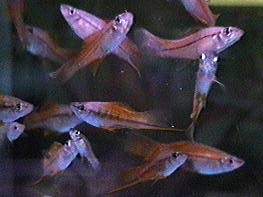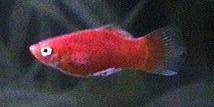
please update your bookmarks!
click banner for the new site and new sections
THIS PAGE IS ACTIVE BUT WILL NOT BE UPDATED, PLEASE GO TO THE MAIN SITE. YOU WILL BE AUTOMATICALLY TAKEN THERE IN 5 SECONDS

|
|

|
|
Live-bearers
FAMILY Poeciliidae
- Livebearing aquarium fish belong to several fish families. What they all have in common is that they do not lay eggs. They give birth to live offspring.
There are some very beautiful wild forms of livebearers, but there are also a great many cultivated varieties that are very popular. Through selective breeding their colors and fin shapes have been changed to create some unusual effects. To view some statistics on many individual fish, just click on any picture.

Male Guppies
Distinguishing traits:
- Because the eggs cells of female livebearers are fertilized inside her body, the male has developed a sexual organ to accomplish internal fertilization. It is a modified anal fin. Because of differences in appearance, it has different names,
Gonopodium in the livebearing tooth carps and the andropodium in the families Goodeidae and Hemirhamphidae.
The Andropodium is folded when inserted into the female,
while the Gonopodium is flipped forward. The development
of the embryos happens in two different way depending on
the species.
- The young develop inside eggs inside the mothers body, hatch there, and then are "born", the Swordtail is an excellent example.
- The young develop without an eggshell inside the mother, receiving nourishment through an umbilical cord, the American Splendens is another excellent example.

Silver Lyretail Molly
Care:
- Most livebearers are schooling fish, and so you should keep more than one of each species. It is also very important to have at least three females to each male, as the males will become to aggressive towards each other and pursue the females without end.
A large densely planted tank with open areas for swimming is ideal. Go easy on the Drift-wood. Livebearers will accept all types of food, but should have some plant material in their diet.
Water:
- For almost all the livebearers, the water in the aquarium should be medium hard to hard and a pH on the Alkaline side, between 7.0 to 7.8. As with all fish regular water changes are important.

Swordtails
Behavior:
- If your interested in watching courtship behavior, then the Livebearers are for you. The males are continuously in courtship display, always chasing after the females. If more than one male is present a pecking order is established with the dominant male
driving away all others. This continues down the order line.
Communities:
- Most livebearers can be kept without any problems with other active schooling fish. Stay away from the larger Cichlids.

Platy
Breeding tips:
- There is no special skill or requirements needed to breed the Livebearers, just have a male and some females and nature will do the rest. Because the babies are born live and quite large, many will survive and grow right in a community tank.

The Characins.
The American Livebearer Association.
Viviparous--livebearer information.

Navigation Console
|
|
